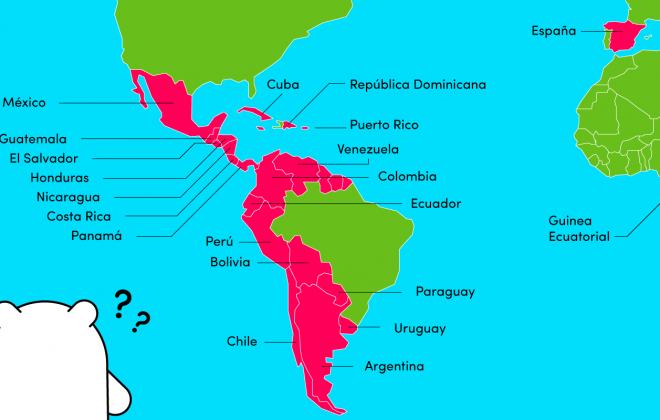Ahorita, an elusive temporal concept
As a Peruvian-German, I’m often torn between two distinctly different languages and thus two distinctly different cultural styles of communication. Because I grew up in Lima and my mother is Peruvian, I have a more emotional connection to Spanish. There is no way that I am going to talk to a baby in German, for example, that will ALWAYS be in Spanish. Much in the same way, if I see a dog somewhere, the first words that I’ll blurt out are going to be ¡cosita linda! (cute little thing).
On the other hand, German is my “academic” language as I studied and have spent most of my adult life in Germany.
It’s not only because of my background that I feel that these two languages are intrinsically different. Their speakers, and I’m including myself here, have ways of communicating that are completely different and that I find fascinating.
Divided by a common language
When I began designing Chatterbug’s study materials, I began thinking about the cultural sides of the Spanish language more closely because of how relevant these are for students learning a foreign language.
At Chatterbug, I work with a Spanish colleague, MJ, and our daily interactions have made me realize that the meaning that we give some words, not only in Peru, but also in many other countries in Latin America, is not always as obvious as I had previously thought it was. Even among native speakers, or maybe especially among native speakers from different parts of the world, misunderstandings can happen because the same word often has completely different, place-specific connotations.
Ahorita, my favourite example
One of the most unique things about the Spanish language, and a distinctive feature of Latin American Spanish, is the use of an excessively imprecise word, that, by its very nature, should actually be crystal clear and unambiguous: AHORITA
Let’s look at a few examples:
– ¿Cuándo bajas? (“When are you coming down?”)
* Ahorita, ma. (“Now, Mom.”)
Ten minutes later…
– ¿Ya? (“Well?”)
– ¿Ya qué, ma? (“Well what, mom?”)
– ¿Ya bajas? (“Are you coming down?”)
– Sí, sí, ahorita. (“Yes, yes, now.”)
Twenty minutes later…
– ¿Ya estás lista? (“Are you ready?”)
– Sí, ma. Estoy bajando ahorita. (“Yes, mom. I’m coming down now.”)
This conversation was once commonplace between me and my mom when I was still living at my parents’ house. And my mom did get quite annoyed with me sometimes but not because of my lack of precision, ahorita is the diminutive form of ahora, which means “now”, but because I just wouldn’t come down.
But I was always convinced that she would understand EXACTLY what I meant (which was “I’m going to come down whenever I’m ready, but I don’t really know how long that’s going to take, but I know you will understand”) and that my reply was as precise as it should, or indeed could have been. And that’s because ahorita is filled with a certain temporal imprecision that makes it possibly the most elusive but at the same time useful word in the Spanish language.
In Peru, ahorita, is an undefined “now” that could actually mean anything from a couple of seconds in the future, all the way to a few days or even years! But why do we have such a concept at all, how do we use it and what does it say about us?
The word ahora means “now”, i.e. at this moment in time or at the current moment in time. But what can be understood by the “current moment”? How much time is comprised within “now”? Time is something relative depending on subjective experience.
Nevertheless, there are certain conventions that we use, such as how long a minute lasts or the date on a calendar hanging on a wall. If we didn’t, how would we ever be on time? How many opportunities would we miss out on because we weren’t somewhere at a specific moment in time?
Using ahorita the Peruvian way
Ahorita is not a word to be used in a context where precision is a matter of life or death. On the contrary, ahorita is used in contexts where we want time to be something flexible, elastic even. Something that can be stretched.

We usually use it when we are doing several things at once; having a shower while talking on the phone with your sister, hanging clothes up to dry, replying to those texts on your phone that have had it buzzing for half an hour, packing your lunch and telling someone on Slack at what time you’re going to make it to the office. For these kinds of occasions, ahorita is the perfect word.
Ahorita! Ahorita salgo! Ahorita llego! (Coming! Leaving now! Will be there in a “minute”!)
(Possibly after you dropped your phone in the shower and your lunch ended up all over the kitchen floor, of course. Might be a while!)
What I find curious is that we prefer it to other words that are (a bit) more precise such as luego, más tarde, después (later) and so on. What matters to us is the emphasis of the fact that it’s going to be “very” soon (almost now!), ahorita, when we’ll get something done. Not later and not in five minutes’ time. But at the same time we don’t want to be committing to it 100%!
But why do we use the diminutive form of ahora?
Pablo Fernández Christlieb, author of the book “Lo que se siente pensar o la cultura como psicología” (2011) explains that, by using the diminutive form, we are effectively taking some of the weight from the message and it goes from sounding a bit like a command to something more like a suggestion.
In the case of ahorita it takes the “temporal commitment” away from the meaning.
“Between promising to do something now, ahora, and promising to do it ahorita, there’s enough time to forget any promise.”
It’s as if it were necessary to leave some undetermined time between the ahora and the ahorita because you can never be quite sure what is going to happen in between. And it’s interesting, because I, for example, would never even think about using the German equivalent (gleich) in the same way that I use ahorita in Spanish.

It’s almost as if speaking Spanish gave me the privilege to not be specific about things, to not live up to my “promises”. And I believe that this is yet another clear example of how language shapes not only the way in which we see the world, but also how we communicate and interact with it. When I change the language I use, I subconsciously adapt my codes of conduct and of communication.
It might also be that the use of the ahorita is a result of a very extended phenomenon in South America: the “inability” to say “no” straight up. Ahorita and a few other expressions make it possible for us to circumvent saying no and evade having to lie, keeping up a kind diplomatic front in our daily lives.
When someone asks you if you’ve got time to get together with them over the weekend, and you know only too well that it’s your granny’s 75th birthday so you don’t, you’re never going to say “no” straight up to them. Instead, you could go for one of these answers, or maybe some other variation of them:
– Ah, no sé, no creo que pueda, pero te aviso. (“Ah, I don’t know, I don’t think I can, but I’ll let you know.”)
– No sé si pueda, pero vamos viendo, todavía hay tiempo. (“I don’t know if I can, but we’ll see, there’s still time.”)
– Mira, tengo este evento, pero seguro me da tiempo. Te voy avisando. (“Look, I’ve got this thing, but I’m sure I’ve got time. I’ll let you know.”)
– Te aviso el viernes y vamos cuadrando. Pero seguro que sí. (“I’ll talk to you on Friday and we can set a time. But I’m sure I can.”)
So why do we do this? Well, for us it is rude to be too direct. We are always trying to find the kind side of things, even when we have to say no to something. Using diminutives and keeping things vague feels like it takes some of the edge and negativity away from our words. This in turn makes it easier for us when it comes to changing our minds and for us to backtrack on our words.
But this is how we understand each other and get along. To us, it seems that when answering with an ahorita, whoever we are talking with is going to read our minds and exactly understand whether we mean right now, in five minutes or maybe never! The proper use of the Peruvian ahorita is definitely almost an art form that has to be learnt through trial and error.
Next time you have someone from Peru tell you that they are going to call you ahorita, don’t get offended if it takes them a full day to actually do it. Similarly, if YOU tell someone that you are going to call them ahorita and you do it the following day and they understand, congratulations; you have mastered the art of using ahorita!
Until then, you can also use all of the following expressions that are also very useful even if just as imprecise 🙂 :
En un rato / en un ratito → in a while / in a little while
Luego / lueguito → later
Más tarde / más tardecito → later
Después → later
I hope the above helps you navigate the seemingly simple but often deceptively confusing Spanish language a little bit better.
Bear in mind that it is a Peruvian perspective and that the use of ahorita can change if you are in other countries! My advice: always observe, listen and learn. Remember that it’s not only the one that uses the term that must understand the nuances, but also the person on the receiving end!
In any case, it’s a fun and interesting word, don’t you agree? 🙂
Want to learn more?
If you’re feeling inspired, sign up below for a free two-week trial and a Live Lesson with a private qualified tutor to start speaking a new language for real! Our classes are structured around exercises created by language teachers, so there’ll be no awkward silences – we promise! 😉
And don’t forget to check out our Facebook, Twitter and Instagram pages for more language content!



